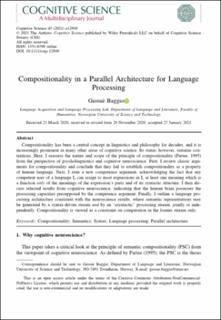| dc.contributor.author | Baggio, Giosuè | |
| dc.date.accessioned | 2022-10-11T14:25:21Z | |
| dc.date.available | 2022-10-11T14:25:21Z | |
| dc.date.created | 2021-05-22T08:13:19Z | |
| dc.date.issued | 2021 | |
| dc.identifier.issn | 0364-0213 | |
| dc.identifier.uri | https://hdl.handle.net/11250/3025419 | |
| dc.description.abstract | Compositionality has been a central concept in linguistics and philosophy for decades, and it is increasingly prominent in many other areas of cognitive science. Its status, however, remains contentious. Here, I reassess the nature and scope of the principle of compositionality (Partee, 1995) from the perspective of psycholinguistics and cognitive neuroscience. First, I review classic arguments for compositionality and conclude that they fail to establish compositionality as a property of human language. Next, I state a new competence argument, acknowledging the fact that any competent user of a language L can assign to most expressions in L at least one meaning which is a function only of the meanings of the expression’s parts and of its syntactic structure. I then discuss selected results from cognitive neuroscience, indicating that the human brain possesses the processing capacities presupposed by the competence argument. Finally, I outline a language processing architecture consistent with the neuroscience results, where semantic representations may be generated by a syntax-driven stream and by an “asyntactic” processing stream, jointly or independently. Compositionality is viewed as a constraint on computation in the former stream only. | en_US |
| dc.language.iso | eng | en_US |
| dc.publisher | Wiley | en_US |
| dc.relation.uri | https://onlinelibrary.wiley.com/doi/full/10.1111/cogs.12949 | |
| dc.rights | Attribution-NonCommercial-NoDerivatives 4.0 Internasjonal | * |
| dc.rights.uri | http://creativecommons.org/licenses/by-nc-nd/4.0/deed.no | * |
| dc.title | Compositionality in a parallel architecture for language processing | en_US |
| dc.title.alternative | Compositionality in a parallel architecture for language processing | en_US |
| dc.type | Peer reviewed | en_US |
| dc.type | Journal article | en_US |
| dc.description.version | publishedVersion | en_US |
| dc.source.volume | 45 | en_US |
| dc.source.journal | Cognitive Science | en_US |
| dc.source.issue | 5 | en_US |
| dc.identifier.doi | 10.1111/cogs.12949 | |
| dc.identifier.cristin | 1911397 | |
| dc.relation.project | Norges forskningsråd: 251219 | en_US |
| cristin.ispublished | true | |
| cristin.fulltext | original | |
| cristin.qualitycode | 1 | |

